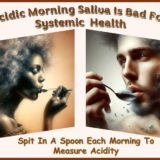Telehealth Reverse Diabetes Action Plan For 2020 | Free Trial In Texas
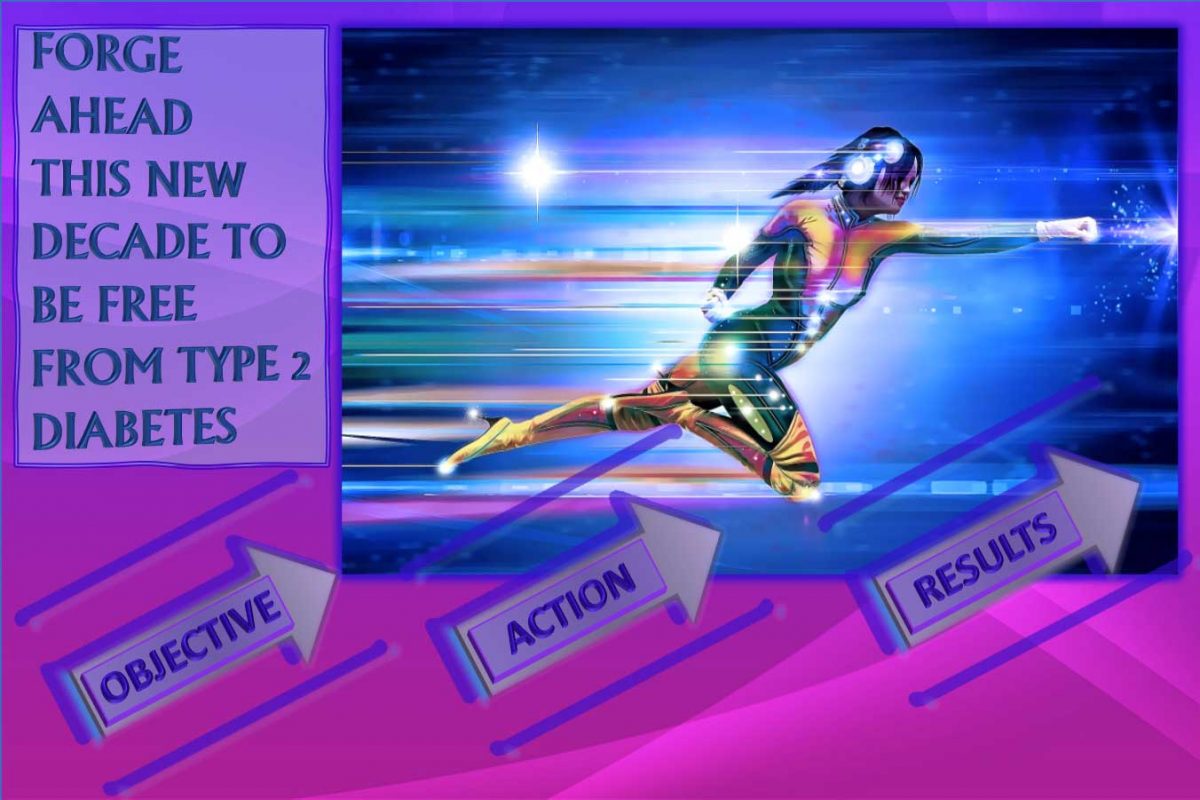
Celebrate the New Year of the New Decade with Recovery from Type 2 Diabetes. Reversal to Remission to Recovery is possible. Why should anyone fail?
Good health skills are learned. Practice, little by little, brings Recovery from Type 2 Diabetes. Let’s get started.Diabetes Action Plan For 2020.
id=”2″ ]
To learn more about programs Herd Healthcare offers, our website is:
www.herdhealthcare.com
History Of Reversal, Remission And Recovery From Overeating
Reversal of diabetes depends on consuming less sugar and fat than is used, stored or excreted. Weight loss is the most obvious physical sign of reversal. A large increase in physical activity may decrease amount of overeating without change in body weight but it seldom creates reversal of diabetes.
Remission is success in reducing levels of sugar in blood without surgery 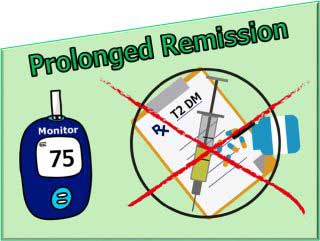 or diabetes medication below measurements diagnostic of type 2 diabetes. It does not mean levels of sugar are in the normal range. Most of all, it does not mean levels of insulin in blood are in the normal range. Consequently, some people with normal levels of sugar and fat have high levels of insulin in their blood.
or diabetes medication below measurements diagnostic of type 2 diabetes. It does not mean levels of sugar are in the normal range. Most of all, it does not mean levels of insulin in blood are in the normal range. Consequently, some people with normal levels of sugar and fat have high levels of insulin in their blood.
Success reaching remission does not mean successful return to normal health. Remission does not remove the danger of insulin and other humoral substances causing hypertension, renal disease and abnormal cholesterol metabolism.
Prolonged remission is 5 years or more of normal blood sugar levels without using diabetes medication.
Recovery from type 2 diabetes means restoring levels of sugar, fat and insulin to normal in the blood. It also indicates reducing dangers of chronic illness and disability.
Remission without full recovery to normal still carries increased risk of heart disease, stroke, cancer, mental illness and dementia.
What’s the Problem? Why is Recovery so Hard? History of recovery from type 2 diabetes and recovery from obesity has been very negative.
Long-term Remission in ordinary adults with type 2 diabetes occurs very seldom. Most clinical studies of reversal and remission have enrolled special patients who are well motivated to improve their health. Unfortunately, most patients with type 2 diabetes do not even try to improve their health. Also, clinical studies of remission seldom report full recovery to normal levels of sugar, fat and insulin in blood.
A study in California about 10 years ago, followed the health of more than 100,000 men and women with type 2 diabetes. All were treated in high quality healthcare clinics and received standard care. After 7 years of follow-up, their laboratory values were studied.
Complete remission was defined as consecutive values for HbA1c under 5.7% over a period of at least 12 months without diabetes medications. The incidence of any remission was 1.5% and the incidence of complete remission was less than 0.01%
Long-term Reversal and Remission in the Look AHEAD Study (Action for Health in Diabetes) occurred only in patients who lost more than -10% body weight. This study recruited 5,145 obese men and women with type 2 diabetes. Those in the intervention group were prescribed food intake of 1,200 to 1,800 kcal/day (depending on body weight) and exercise that was gradually increased up to 175 min/week.
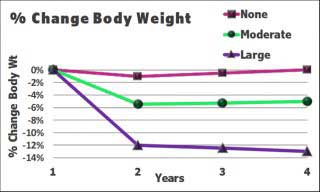
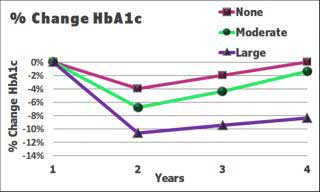
Patterns of weight loss and reduction of HbA1c were assessed at baseline, again after 1 year of intensive treatment and finally after 4 years of treatment. All participants had their greatest weight loss and greatest reductions in HbA1c measured 1 year after beginning treatment. Larger weight losses were associated with greater reductions in HbA1c.
As shown in the Figures, those who lost more than -10% of body weight were most successful in maintaining reversal of HbA1c. This happened in about 18% of the intensively treated group.
Complete remission was defined as HbA1c under 6.5%. Complete remission for 4 years occurred in 3.5% of those intensively treated.
 Patterns of early weight loss >-10% show greatest likelihood of long-term remission. Weight loss >-10% in the first 12 months makes it twice as likely complete remission will last at least 5 years.
Patterns of early weight loss >-10% show greatest likelihood of long-term remission. Weight loss >-10% in the first 12 months makes it twice as likely complete remission will last at least 5 years.
Successful weight loss maintenance has been analyzed in the National Weight Control Registry. Those most successful follow several health practices. They monitor and limit what they eat, weigh themselves frequently and exercise regularly at least 400 minutes a week. The most common exercise was walking briskly every day for about an hour.
Amount of energy spent on exercise by men was about 3,000 kcal/week or about 500 kcal/day. Women spent about 2,500 kcal/week or about 400 kcal/day.
Body composition with complete recovery from type 2 diabetes includes:
•% Body fat (BF) of 25% for men and 35% for women
•Maximum waist circumference of 35 in for men and 32 in for women
•% Muscle mass (MM) of 35% for men and 30% for women
Indicators for successful recovery from type 2 diabetes include:
•Weight reduction >-10% in the first 12 months
•Exercise of moderate intensity about 60 minutes every day
•Body composition (%BF|%MM) 25|35 for men and 35|30 for women
Action Plan For Recovery From Type 2 Diabetes
Awareness about benefits of good health and costs of type 2 diabetes is important. If you’re not sure about costs and benefits, check our website at www.diabetesriskalert.com.
Motivation for reversal, remission and recovery can be expressed, measured and checked. The first step is to write down what you want, why you want it, what you intend to do to make it happen and when you’ll do it. Until you think it through and write it down, it’s not going to happen.
Priority in your life for Recovery from type 2 diabetes is what can be measured right now. It must be the first, second or third on your list.
 Think through your situation now and figure out both the opportunities and the barriers working for or against your ambition. Most important is to think about the rewards and pleasure good health will bring you. Write that down.
Think through your situation now and figure out both the opportunities and the barriers working for or against your ambition. Most important is to think about the rewards and pleasure good health will bring you. Write that down.
Checking strength of your motivation to get started is assessing your progress in a week or two. If you just say you’ll do something when you’re ready, probably nothing will happen. If I’m wrong, I’ll be really pleased when you call me in a year and tell me how you achieved complete recovery without following a written action plan.
Notes and Records are basic to this action plan. Type or write everything into a file or a notebook. Type text into a note-keeping app like Google Keep or write notes in the pages of a journal.
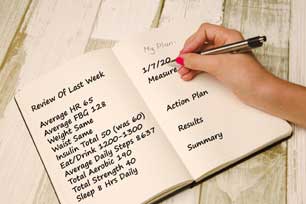 Information to Record:
Information to Record:
•Measurements: Basal HR, FBG, Body Wt, max WC, Insulin injected, Minutes of exercise/week, Hours of sleep, 6-min Walk Test, Strength tests
•Objectives and descriptors: Exercise, Food and drink, Sleep patterns, Stress management, Relaxation, Recreation and Entertainment
•Action plan: for daily routine and deliberate efforts to improve
•Results: Day-by-day and Week-by-week
•Summary: Week-by-week Analysis with Revisions according to Results
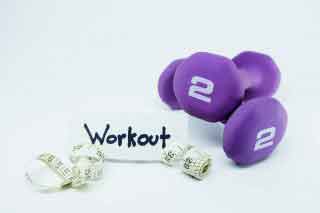
Exercise is essential. It is the resource to:
•Provide satisfaction and pleasure
•Increase energy storage potential in muscle, liver and fat tissue
•Build and maintain muscle mass and strength during weight reduction
Neurocognitive function is the basis for automatic responses that initiate plans 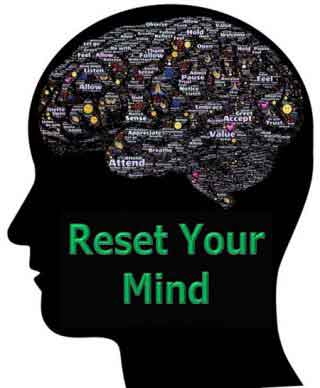 and practices. Almost every action, reaction, mental response and emotion is governed by memory of lifelong experiences. Conscious plans, actions and responses govern only a small proportion of behavior.
and practices. Almost every action, reaction, mental response and emotion is governed by memory of lifelong experiences. Conscious plans, actions and responses govern only a small proportion of behavior.
Nonconscious automatic function can be reprogrammed. It happens little by little, day by day with conscious actions in specific situations. Highly desired results and positive outcomes adjust and retrain automatic responses.
Retraining requires months of repetition using conscious effort to transform desired actions and reactions into nonconscious automatic practice.
Gene expression is the metabolic and mechanical output of cellular function. It’s  what’s inherited and what’s been learned. It’s even what parents and grandparents inherited and learned to do.
what’s inherited and what’s been learned. It’s even what parents and grandparents inherited and learned to do.
Cellular function is shaped further by prenatal environment, childhood development, adult actions and lifelong experience. Every automatic function that is gradually reprogrammed alters gene expression.
Improvements in good health practice alter gene expression. What we learn to practice automatically is passed to our children by gene expression as well as by example and instruction.
Getting Started
Type or write your Objective
• Make it Consistent with SMART criteria
(Specific, Measurable, Achievable, Relevant, Time-defined)
 •Give it a High Priority
•Give it a High Priority
(In top 3 of personal concerns and desires)
•Find a Critical Measurement that indicates progress
Type or write one thing you will do several times next week. Choose something that you like to do and will advance you towards your objective.
Check each week whether you did what you predicted. Make it harder for the following week if you did it. Make it easier if you didn’t.
Make an investment
Pay someone to coach you, sign up for a class, join a health club, buy some equipment.
Regular routine review and revision
•Find out what you can do for sure
•Find out what you can reasonably expect to achieve
 Set an automatic reminder at a convenient time each week to review, analyze and revise. For example, set a specific time each day for exercise.
Set an automatic reminder at a convenient time each week to review, analyze and revise. For example, set a specific time each day for exercise.
Check at this time next week to see if you have adopted any of this Action Plan for 2020.
Summary
Short term positive results are essential to support strong motivation.
Exercise improves metabolism, strength and mental health.
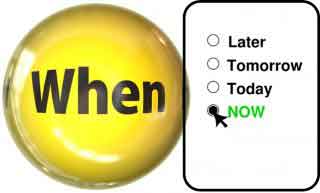 Weight reduction is the best indicator of progress towards recovery.
Weight reduction is the best indicator of progress towards recovery.
Body Composition determines capacity for improvement.
Plan something NOW that you can check for progress in a week.
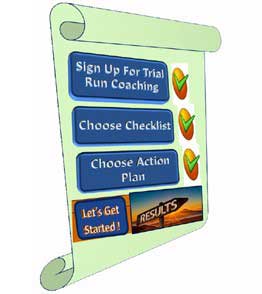
We are pleased to share our blog articles with you, and we are always interested to hear from our readers. Our website address is: www.herdhealthcare.com



